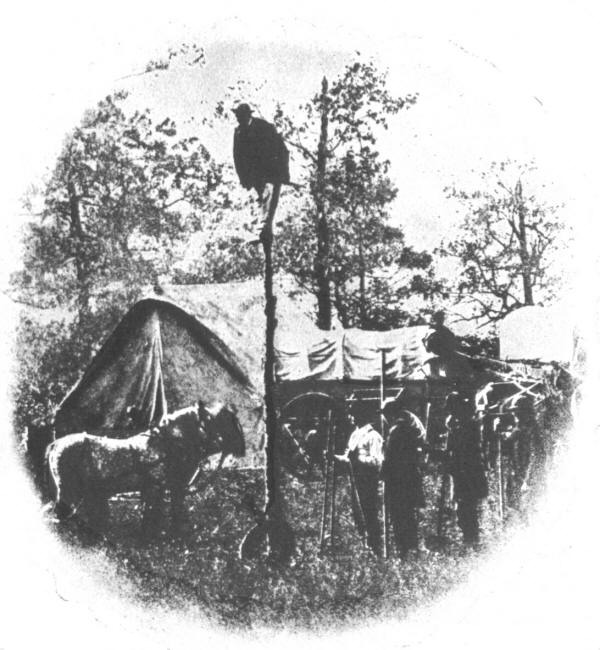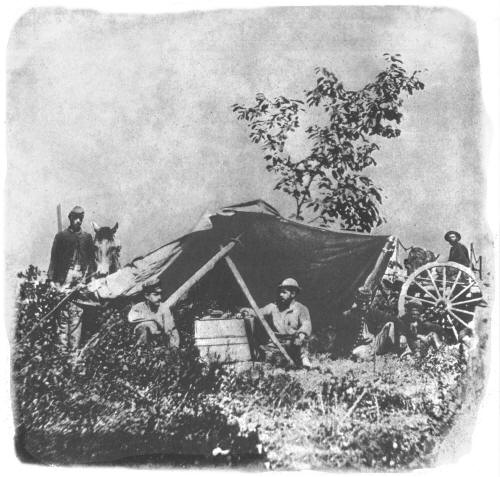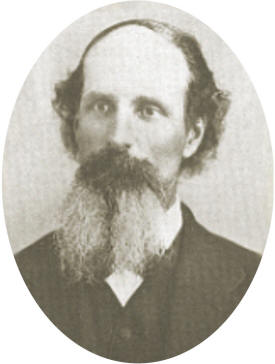Clark County WI
Civil War Unit Histories
Compiled by Paul Forester, Janet Schwarze, Allan Wessel & Ken Wood
5th Wisconsin Regiment
Our Civil War Veteran who fought with this Regiment
William Henry Harrison
Enlisted as a Private and was discharged as a Corporal
Co. C, B (served the last year of the war installing telegraph wires).
On the muster out of service of the "Old Fifth," Governor Lewis authorized its reorganization, and decommissioned Colonel Allen as the colonel. Under his supervision, seven companies were rapidly recruited, organized and mustered into the United States service, and left the State on October 2, 1863, to join the battalion at Winchester. The following is the roster of the reorganized regiment:
Colonel - Thomas S. Allen.
Lieutenant Colonel--James M. Bull; Major- Charles W. Kempf; Adjutant- Wm. B. Sturges; Quartermaster- Alexander Samuels; Surgeon-George D. Wilbur; First Assistant Surgeon-Ambrose Jones; Second Assistant Surgeon-William W. Allen; Chaplain-Rev. B. C. Hammond.
|
Captains |
First Lieutenants |
Second Lieutenants |
|
|
Co. |
Name |
|
|
|
A |
John B. Doughty |
Charles Mayer |
Henry Curran |
|
B |
Charles D. Moore |
Theodore Marcot |
Benjamin Smith |
|
C |
Miles L. Butterfield |
Henry H. Linnell |
Evan R. Jones |
|
D |
John W. Van Myers |
James LaCount |
John S. Cooper |
|
E |
Charles R. Nevitt |
John McCabe |
Percy B. Smith |
|
F |
William Bremmer |
John Jolley |
Calvin D. Richmond |
|
G |
Henry L. Walker |
Ransom D. Squires |
Charles J. Bracken |
|
H |
Charles T. Wyman |
Harmon S. Kribb |
H. L. Furr |
|
I |
Thomas Flint |
Lars E. Johnson |
Nelson E. Allen |
|
K |
S. A. Hall |
Lewis A. Day |
Alfred T. Fleetwood |
The seven companies arrived at Washington, received arms, and were sent to Alexandria, where thy remained, doing provost guard duty, until the 20th of October, when they proceeded by way of Martinsburg and Winchester to Cedar Creek, where they joined the battalion and the forces under General Sheridan, and remain at that place until the 1st of December, Colonel Allen being put in command of the brigade. with the Sixth Corps, they rejoined the forces of General Grant in the trenches before Petersburg on the 4th of December, where they remained until the 5th of February, 1865, when they took part in the extension of the lines at Dabney Mills, on Hatcher's Run, suffering little loss in that engagement, being held in the reserve. Riley C. Tryon, Company G, and Charles Berringer, Company C, were wounded.
On the 25th of March, 1865, the regiment participated in the general skirmish along the whole line, and succeeded in driving in the rebel outpost then in front. Here Sergeant William Hall, Company C, was killed, and Corporal James D. Splain, Company G, Edward Martin, John Morrison and H. S. Otis, Company D, and Charles O. Foot, Company K, wounded. Edward Martin is reported as having died of his wounds.
In the charge on the enemy's works at Petersburg, April 2nd, the Fifth Wisconsin and Thirty-seventh Massachusetts, led by Colonel All, were in the extreme front, supported by two lines in the rear. At 4, A. M., the signal for the charge was given, and the colors of the Fifth were the first planted on the enemy's works, that regiment being the first to enter the captured works of Petersburg. Colonel Allen led a portion of the regiment two miles through the abandoned lines of the enemy to the South Side Railroad. By 8, A. M., the troops were reassembled, marched six miles to the left inside of the late rebel works, capturing many prisoners, then back to the right, where the regiment was engaged in skirmishing till night. The losses as officially reported were:
Killed-Company A-Captain John B. Doughty. Company E-Privates William H. Arnet and Ira Gilman. Company F-Privates H. Lysner and Albert A. Beggs. Company G-Private Hiram Billington. Company H- Private Allen Graham. Company I-Private Frank Gilbert.
Wounded-Company A-Lieut. Charles H. Mayer, died, Privates Ferdinand Werhite, August Ahrendt and Benjamin Mitchell. Company B-Lieutenant Benjamin Smith, Sergeant P. W. Lord died; Private L. Bishop. Company C-Lieutenant E. R. Jones, Sergeant Thos. Larkin, Private Hirman Brown, died, and Fred Mercier. Company D--Sergeant J. G. Troy, Corporal Wm. L. Moffatt, died, Privates P. H. Blodgett, Herbert Ward and Calvin Blood. Company E"Sergeant Thomas K Chubbudk, Corporal Gilbert B. Main, Privates A. C. Phelps, Stephen Meridam, George H. Hutsell, John H. Park, George Knowles. M. Meutsti, Daniel S. Edson, William H. Hoskins, J. M. Ruibank, Gustavus Hirsch end George W. Barton. Company F"Captain William Bremer, Sergeant Ed. A. Allen. Privates Jos. Echman, died; Ellas Marlatt, died, Jas. Bower, Peter Reuther, B. L. Aber, died A. Dorman, S. M. Manly, A. D. Cory and Wm. M. Phelps, died. Company G" Lieutenant K. D. Squires, Sergeant Samuel F. Daggett, Privates Thomas Roach, N. J. Barker, K. C. Barker, Wm. Flynn, died, F. A. Bovee and E. Running. Company H" Corporal H. P. Cody, Privates A. W. Baswell, Luther Shooner, August Leoney, F. W. Beahel and John Rehome. Company I"Corporals George West and William Smith, Privates John Bra died; James Dunn, Thomas Underwood, Theophilus George, B. Tully, John Lemuel, Heary Tipp, B. H.. Fessenden, George Vanderbloom, James Willie and Spencer Hurlbut. Company K"Sergeant John 8. Barger, Seymour Beaman, Joseph Leleta, D. K. Babcock and Fred Ringling"71. Died of wounds, 9.
The loss of the regiment was about one-tenth of that suffered by the whole corps, consisting of fifty regiments.
On the afternoon of April 3d, they joined in the pursuit of Lee, marching with great rapidity by day and night. The Sixth Corps encountered General Ewell's forces at "Little Sailors' Creek," on the 7th. The lines were hurriedly formed, and they pushed forward at a double quick, the regiment marching with unbroken line through a swamp waist deep, under the fire of the enemy's musketry. They moved to the brow of a hill, where the enemy was discovered but a few paces distant, admirably posted, and fighting with the energy of despair. The regiment was in an extremely hazardous position, being subjected to a severe flank and cross fire. Colonel Allen rode in advance of the line as calmly as though danger was unknown. Company G, Captain Henry Curran, and Company C, Lieutenant Evan R. Jones, were deployed as skirmishers. Lieutenant General Ewell and staff, surrendered to six men of the skirmishers, under command of Sergeant Cameron, Company A, who was promoted Lieutenant on the field, for his gallantry. The action of the regiment elicited high encomiums from the corps, division, and brigade commanders.
The following were the casualties in the action of April 7th, as officially reported:
Killed" Company A " Private Gustave Loeffler. Company B
" Private John Rierdon. Company C"Color Corporal Alexander Johnson
and Corporal John L. Heberlies. Company D"Sergeant John Purdy,
Privates John Gallagher and Ly.ander H.. Muzzy. Company E"Privates
Allen K. Augur, George Mills and J. D. Gurney. Company F-Corporal
George L. Welty, Privates C. Truax and George Truax. Company G"Privates
James Conlin and Stephen Smith. Company H"Private Edmund Bigford"l6.
Wounded." Company A "
Color Corporal August Franz, Sergeant William H. Landott, Privates Christian
Erickson, Duncan McLenan, Charles Rhefl'net, Robert Miller and C.
Spinner. Company B" Corporals William Mead and Johnson,
privates George H. Rees, J. H. Keyes and P. Wells. Company C"Privates
Cornelius H. Bonnell and Ephraim
Purdy. Company D"Privates George Roes. George Buffin, died, James
Tooney, Francis Goodness, Freedom Cromwell, John Banker, John Nelson,
William Conniff Lyman
Smith and Milo Wells. Company E"Corporal B. W. Mellon, Private.
Theodore Bandow, John Polar, Abram Casalar, Thomas Leet and W. Lansing.
Company F"Captain William Bremer, Private. C. H. Gee, Orson Foucher,
Fred Gross, Andrew McFadden, Angust Gessel, Reuben Stock, John Hanson,
Theodore Lzeekleba, Andrew Rowe. O. Gesse and F. Ott. Company G"Corporal
John W. Curran, Privates Samuel Vasnow, Lewis A. Nelson, Edward Tierney,
Smith Owen, John W. Stafford, Adeibert B. Lane Thomas Marshall, Torger
Peterson, I. W. Stoner, Alexander Hamilton, Charles C. Vanalstine, died;
John Stetaner, John Sucbner and Simon Anderson. Company H"Sergeant
Charles B. Woodridge, Privates Peter Peterson and John L. Nelson. Company
I"Private, Henry Goodman, Daniel Smith, Jacob Peterson and T. Czeskleba.
Company K" Color Corporal John O. Hoisington, Corporal George C.
Lefever, Privates J. B. Whitney, H. D. Warden, Nelson Gillett, Nicholas
Hammond, Albertus Hoffman, J. W. Wiggins,
D. P. Howell, J. D. Crapser, M Ware, Cordon Wyman, M. H. Parcel, died, L.
Persons and C. O. Foote--79, Died of wounds, 3.
The pursuit was continued until the 9th, when Lee surrendered. On the 10th,
the regiment commenced its return, and reached Burke's Station on the
evening of the 13th, encamped till the 23d, and marched to Danville,
arriving there on the 27th, left Danville, May 3d, by rail, arrived at
Wilson's Station, May 4th, and May 18th, marched for Richmond, which they
reached on the 20th. On the 24th, left Richmond, for Washington, where they
arrived on the 2d of June, after a long and tedious march. Left Washington,
June 16th, and arrived at Madison,
June 20th, and were soon after mustered out, thus closing the record of the
"Fighting Fifth."
Colonel Allen was brevetted Brigadier General for gallant and meritorious
services during the war.
Statistics. " Original strength, 1,058. Gain "by recruits in 1863, 210, in
1864, 684, in 1865, 25; by substitutes, 50; by draft in 1865, 25; by veteran
reenlistment, 204; total, 2,256. Losses"deaths, 285; missing, 4; desertion,
105; transferred, 33; discharged, 405; mustered out, 1,424.
Source: The Military History of Wisconsin in the War for the Union by E. B. Quiner, 1866
TELEGRAPHING FOR THE ARMIES

ANDREW CARNEGIE SUPERINTENDED
MILITARY RAILWAYS AND GOVERNMENT TELEGRAPH LINES IN 1861
The man who
established the Federal military telegraph system amid the first horrors of
war was to become one of the world's foremost advocates of peace. As the
right hand man of Thomas A. Scott, Assistant Secretary of War, he came to
Washington in ‘61, and was immediately put in charge of the field work of
reestablishing communication between the Capital and the North, cut off by
the Maryland mobs. A telegraph operator himself, he inaugurated the system
of cipher dispatches for the War Department and secured the trusted
operators with whom the service was begun. A young man of twenty- four at
the time, he was one of the last to leave the battlefield of Bull Run, and
his duties of general superintendence over the network of railroads and
telegraph lines made him a witness of war's cruelties on other fields until
he with his chief left the government service June 1, 1862. Source: "The
Civil War through the Camera."

THE MILITARY FIELD TELEGRAPH
"No orders ever had to be given to establish the telegraph." Thus wrote
General Grant in his memoirs. "The moment troops were in position to go into
camp, the men would put up their wires." Grant pays a glowing tribute to
"the organization and discipline of this body of brave and intelligent men."
Source: "The Civil War through the Camera."
BUCKNER'S TELEGRAPH
The most ingenious contrivance that has yet come to light, as an emanation from the secession mind, is a telegraphic communication between Gen. Bruckner's headquarters at Dover, and the different fortifications at Fort Donelson. A wire extends from the headquarters all through the fort with batteries at each redoubt and important point. By this means it was calculated that troops could be easily ordered from place to place with much greater speed than by the usual means of a courier on horseback. While the engagement of Saturday was going on, Gen. Buckner stood upon a hill in the rear of the fort, viewing everything through a spy glass. A telegraphic operator was by his side, with a 'pocket instrument' in his hand. and by this means all orders were transmitted from the commanding officer to the troops within the fort." Source: Rochester City Post (Rochester, MN) 2/Apr/1862

ONE OF GRANT'S FIELD-TELEGRAPH STATIONS IN 1864
This photograph above was taken at Wilcox Landing, near City Point, gives an
excellent idea of the difficulties under which telegraphing was done at the
front or on the march. With a tent-fly for shelter and a hard-tack box for a
table, the resourceful operator mounted his "relay," tested his wire, and
brought the commanding general into direct communication with separated
brigades or divisions. The U. S. Military Telegraph Corps, through its
Superintendent of Construction, Dennis Doren, kept Meade and both wings of
his army in communication from the crossing of the Rapidan in May, 1864,
till the siege of Petersburg. Over this field line Grant received daily
reports from four separate armies, numbering a quarter of a million men, and
replied with daily directions for their operations over an area of seven
hundred and fifty thousand square miles. Though every corps of Meade's army
moved daily, Doren kept them in touch with headquarters. The field-line was
built of seven twisted, rubber-coated wires which were hastily strung on
trees or fences.
A Clark County, Wisconsin pioneer, William Harrison Mead, Second Biography"was engaged in the installation of telegraph wires for the Union Troops during the last two years of the war.

